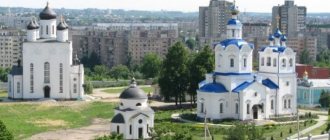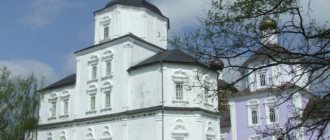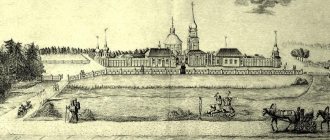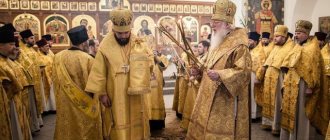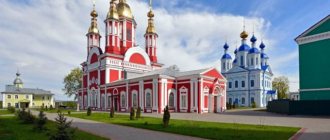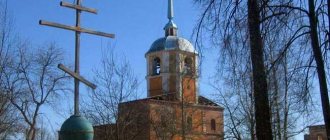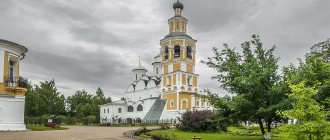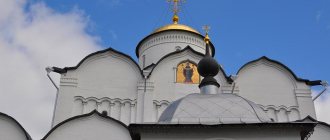Story
Despite the ancient affiliation of Samara and its region to the Orthodox faith, this region gained independence not so long ago - the Samara Metropolis was created in 2012, and the Togliatti diocese separated from its composition only in the summer of 2019 and became one of the five dioceses of the metropolis.
Tolyatti Resurrection Monastery
A corresponding decree was issued by the office of the Holy Synod, which is dated July 9, 2021. The archbishop received the title of Tolyatti and Zhigulevsky.
Geographically, the diocese includes the urban districts of the cities of Togliatti and Zhigulevsk, parts of the Stavropol region (the left bank part of the Samara and the right bank of the Syzran dioceses). In addition to defining the main boundaries of the independent unit, decisions were made about some separate monasteries.
Thus, the Holy Mother of God Kazan Monastery, together with the spiritual and educational center located in it, despite its territorial location, remained under the direct jurisdiction of the metropolis, since its significance is too great for the entire region.
A similar decision was made regarding the Volga Orthodox Institute, as well as the Holy Trinity Monastery - they are managed by the head of the Samara Metropolis, despite their territorial location.
Resurrection Monastery in Tolyatti Diocesan monasteries of the Russian Orthodox Church
The Resurrection Monastery began its existence with the Assumption Parish. In 1995, the city allocated land in Portposelok for the construction of the Church of the Assumption of the Blessed Virgin Mary. To work on the construction of the temple, temporary premises were needed. In November 1995, the city department of culture concluded a lease agreement with the Assumption Parish for four buildings of the former zemstvo hospital for a period of 5 years. In 1996, a fund for the construction of a spiritual and cultural fund was registered in Tolyatti, designed to help resolve issues related to the restoration of the buildings of the former zemstvo hospital.
Due to the need for spiritual nourishment of the community, it was decided to convert one of the premises of the former hospital into a temple. In the fall of 1996, the establishment of a house church began.
On January 14, 1997, the first water prayer service took place in the church, and services began in February.
On June 1, 1997, on the day of the 260th anniversary of Stavropol, Bishop Sergius consecrated the throne of the temple in honor of the Holy Resurrection of Christ.
On September 23, 1997, the complex of buildings of the zemstvo hospital was completely transferred to the Resurrection parish. A blacksmith, art and gold-embroidery workshop were organized on the territory of the parish.
On December 25, 1997, by the decision of the Holy Synod and Patriarch of Moscow and All Rus' Alexy II, the temple was given the status of a monastery. The Holy Archimandrite of the Holy Resurrection Monastery is Metropolitan Sergius of Samara and Syzran.
In February 2005, Archimandrite Hermogenes (Kritsyn) was appointed acting abbot of the monastery.
On July 17, 2006, the Holy Synod of the Russian Orthodox Church confirmed Archimandrite Hermogenes as abbot of the Holy Resurrection Monastery. Several objects appeared in the monastery: a building for household purposes, a malt mill, a food warehouse, a food pre-processing shop, a new building for the brethren of the monastery, a hotel for pilgrims for 40 people, a new monastery wall was erected on the side of the Zhiguli Sea, and the main eastern entrance was decorated with new holy gates , parking was arranged for the cars of pilgrims and parishioners, gas, water and heating were installed in the monastery territory, and the abbot's building and the fraternal building were restored. For the 10th anniversary of the monastery, the Church of the Resurrection of Christ was completely renovated. The interior of the temple was completely changed: the walls and ceilings of the altar, choir, and vestibule were completely occupied by painting with wall icons, the walls of the middle part were decorated with Orthodox ornaments. The exterior of the building has also been updated. There are flower beds along the road to the temple.
On September 24, 2005, in the refectory building of the monastery, Archbishop Sergius of Samara and Syzran (now Metropolitan) consecrated a temple in the name of St. Silouan of Athos.
In 2008, on the day of the patronal feast of the Resurrection of the Word, after the festive liturgy, Archbishop Sergius of Samara and Syzran (now Metropolitan), consecrated the site for the construction of a temple in honor of the icon of the Mother of God “Consolation and Consolation”.
Currently, the construction of the monastery continues. The abbot and fraternal building No. 1 underwent a complete reconstruction. A utility building and a hotel for pilgrims were built. It is planned to build a bishop's house and reconstruct the 2nd and 3rd fraternal buildings.
At the end of 2021 The walls of the monastery were completely erected, the roof of the temple was covered and 7 domes were installed. The territory of the monastery is being improved.
Activity
The work of the entire diocese and its departments is controlled by the head of the association, Nestor (Lyuberansky), who has held this post since the summer of 2019, i.e. from the very first day of the diocese's existence. All 7 deaneries are subordinate to him:
- Tashlinskoe;
- Zhigulevskoye (including the city of Zhigulevsk);
- Stavropol;
- Togliatti;
- Preobrazhenskoe;
- Central;
- Nevskoe.
Bishop Nestor has headed the Togliatti diocese since 2021
The activities of all parishes and social institutions are controlled by special diocesan departments:
- youth affairs;
- missionary;
- public relations;
- on working with government authorities;
- social assistance;
- educational.
All their work is aimed at ensuring that the diocese functions and provides the population not only with spiritual assistance, but also with physical and social assistance. That is why a number of social institutions were launched from the very beginning of its existence. The main social project is an almshouse for the elderly and dying at the Church of the Kazan Icon of the Virgin Mary in the administrative center of the region.
Great attention is paid to the spiritual education of the population, so it was decided not only to publish news and useful materials on the main website of the diocese, but also to publish a monthly newspaper “Church Bulletin” in the Togliatti deanery and the newspaper “With Faith in Life” in Zhigulevsky.
Orthodox Temples Tolyatti
Preobrazhenskoe deanery in Avtozavodsky district
| Spaso-Preobrazhensky Cathedral Leninsky Prospekt, 32 |
| Temple in honor of John the Baptist st. Revolutionary, 19 building 1 |
| Temple in the name of the Ecumenical Teachers and Saints Basil the Great, Gregory the Theologian and John Chrysostom |
| Temple in honor of the Intercession of the Blessed Virgin Mary st. Voroshilova, 2 b |
| Parish of the Holy Venerable Seraphim of Sarov Stepan Razin Ave., 86 a |
| Church of All Saints who shone in the Russian land st. Revolutionary, 74 |
| Temple in the name of the Holy Archangel Michael st. Zastavnaya, 2 a |
| Church in honor of the icon of the Most Holy Theotokos Spreader of the Loaves st. Vokzalnaya, 21 b |
| Church of the Three Saints Basil the Great, Gregory the Theologian and John Chrysostom st. Yubileinaya, 4 a |
| Wedding Church in the name of Saints Peter and Fevronia st. Revolutionary - at the Wedding Palace. |
| Temple in honor of the icon of the Mother of God Quick to Hear st. Revolutionary, 3 |
Nevsky deanery in Avtozavodsky district
| Temple in honor of Saint Righteous John of Kronstadt st. 70 years of October, 62 |
| Temple in the name of the Holy Great Martyr and Healer Panteleimon Bulvar Zdorovya, 25 |
| Temple of the Great Martyr. St. George the Victorious (under construction) st. 40 Years of Victory |
Central deanery in the Central region
| Temple in the name of the Kazan Icon of the Mother of God st. Vavilova, 2 |
| Temple in honor of the Holy Trinity st. Golosova |
Church of the Assumption of the Blessed Virgin Mary and the house church in honor of the Holy Blessed Prince Alexander Nevsky
Komsomolskoe highway, 2a
Temple in the name of the holy martyr Tatiana
st. Belorusskaya, 14
Temple of All Saints
Obvodnoye Highway, 1 g
Temple-chapel of St. Blessed Xenia of St. Petersburg
st. Oktyabrskaya, 68
| Chapel in honor of the Nativity of Christ Central district, Central square. |
| Temple of the Prophet Elijah st. Banykina 41a |
Chapel in honor of the holy great martyr and healer Panteleimon
st. Banykina, 8
Tikhonovsky deanery in Komsomolsky district
| St. Tikhon's Church st. Liza Chaikina, 28 |
| Temple-chapel in honor of the Holy Blessed Queen Tamara st. Matrosova, 19 in |
Temple in the name of the Holy Venerable Seraphim of Sarov
st. Zheleznodorozhnaya, 23
Temple in honor of the Blessed Matrona of Moscow
Povolzhskoye Shosee, 5
Annunciation Skete - Church of the Annunciation of the Blessed Virgin Mary and a refectory church in honor of the Holy Great Martyr Barbara
Fedorovka village, st. Cooperative, 27 a
Temple in the name of the Holy Archangel Michael
Povolzhsky village, st. Polevaya, 28
Temples of Tolyatti
06/20/2018 Almost every city can boast of its old wonderful churches. Although our city has not preserved the architectural structures of the 18-19th centuries, the churches of our city are not inferior to many in their beauty.
From the history of the construction of temples in Tolyatti
After Stavropol was moved to a new location in 1953-1955, a wooden prayer house was built in honor of the Kazan Icon of the Mother of God with the St. Nicholas chapel. By this time, the believers in the old prayer house were cramped and unsafe: the walls were almost falling apart.
In 1985, on the site of the Theotokos-Kazan prayer house, a temple was built, the main altar of which was consecrated in honor of the Kazan Icon of the Mother of God.
The first temple of the city of Tolyatti is located on Vavilova passage, 2.
Temples of Stavropol
But let’s return to the oldest church in our city of Stavropol. Between the founding of the city in 1737 and until 1750, five Orthodox churches were built in Stavropol. The largest of the churches in Stavropol was the Trinity Cathedral. It, like the rest of the churches and cathedrals, was blown up and dismantled, and then flooded along with all of old Stavropol.
There is a legend that in 1894, the holy righteous John of Kronstadt predicted the future flooding of Stavropol: having visited the city, he served a prayer service in the Trinity Cathedral, and then told those gathered: “Your town is good, but it will be flooded with water.”
Trinity Cathedral.
Trinity Cathedral, built in 1738, became one of the very first buildings in the city.
It was to the Trinity Church that the ancient icon of the Kazan Mother of God was transferred, which was kept in the family of retired colonel Soshalsky for 300 years. In the temple there was a golden cross, inside of which there were pieces of the relics of Saints Andrew the First-Called, the unmercenaries Cosmas and Damian, George the Victorious and others. However, to Vasily Tatishchev, who oversaw the construction of the city, the original wooden church seemed small, so already in 1739 the construction of a new five-domed Trinity Cathedral began. It took four years to build it. But, probably due to the low qualifications of the builders, it fell into complete disrepair soon after construction was completed. The building was rebuilt for the third time in 1750. There was no heating in the new cathedral, so services were held only in the warm season, and in cold weather the service was held in the winter chapel. The Volga constantly eroded the banks on which the city stood, and at the beginning of the 19th century, when there was a threat of flooding of the embankment, it was decided to move the temple away from the shore.
In 1809 it was dismantled and rebuilt in the city center. The street where he was located was called Soborna. On September 7, 1824, Emperor Alexander I attended the service in the cathedral. Saint John of Kronstadt also served in the Trinity Cathedral during his visit to the city in 1884.
In 1842, a 55-meter bell tower was erected next to the cathedral - according to the design of the Simbirsk architect Lizogub. It was equipped with a warm church with a chapel that could accommodate up to a thousand people.
At least twice the temple was seriously damaged by fire. However, in 1909, it operated an elementary two-year school and a library, and the number of parishioners reached almost five thousand people. In 1921, under the pretext of helping the starving people of the Volga region, the Bolsheviks confiscated valuables from churches. Despite formal instructions to take only unnecessary things, everything was taken out of the temple: silver icons, crosses, vestments. The same fate befell other churches in Stavropol.
In 1930, all bells were removed from the Trinity Cathedral and the Assumption Church. On January 30, at a general meeting, local residents, as recorded in the documents, “unanimously and unanimously” voted to remove the bells from the cathedral. They, including the main 400-pound bell, were smashed with sledgehammers, loaded onto barges and sent for melting down. According to some reports, some of the bells sank along with the barge on which they were transported near the village of Brusyany, and some sank to the bottom of the Volga along with a piece of the bank, where they were stacked in anticipation of the barges. From the entire belfry, only one ringing bell has survived (now located in the funds of the city museum complex “Heritage”). The cathedral was finally closed in November 1936. A granary was placed in it. And on May 31, 1955, the Trinity Cathedral was blown up. Attempts were made to dismantle the temple brick by brick and break it with a bulldozer, but the brickwork turned out to be very strong. For a long time, there was an urban legend that at the bottom of the Volga Reservoir, at the site of the flooding of Stavropol, there is a partially surviving church. It was sometimes claimed that sometimes, when the water is clear, you can see the cross on the cathedral underwater. However, this legend was refuted by Tolyatti divers. The church was blown up and destroyed to the ground. Its height was 63 meters, and the place where it was located was flooded by only 9 meters. At the bottom of the Volga, only part of the foundation and a few steps remained from the cathedral.
Construction of the Trinity Cathedral in honor of the temple blown up in Stavropol
The idea of building a new church with the old name in memory of the first cathedral of Stavropol, destroyed during the transfer of the city during the construction of a hydroelectric power station, arose a long time ago. A place was allocated and a preliminary design of a large-scale temple complex was drawn up. In September 1999, Archbishop Sergius of Samara and Syzran served a water prayer service, consecrating a cross at the site of the construction of a temple in memory of the blown up Trinity Cathedral of Stavropol-on-Volga. On October 14, Patriarch of Moscow and All Rus' Alexy II, driving past the cross, blessed the creation of a future parish in honor of the Holy Trinity and an altar in the name of the Apostle and Evangelist John the Theologian. This construction was the first stage in the construction of the parish complex.
At the end of 2003, the temple was consecrated. It is designed for approximately 200 parishioners, has an altar and iconostasis painted in the Old Russian style. And since 2011, with the blessing of Metropolitan Sergius of Samara and Syzran in Togliatti, on the territory of the parish in honor of the Holy Trinity, the first children's educational center has been built by the church and parishioners, the mission of which is to give children a moral and spiritual education.
The center building will be two-story. If a library, conference room, and gym are planned on the first floor, then on the second floor there will only be classrooms in which classes will be held for children.
Moreover, primary school classes will be held in the first half of the day, and in the second half of the day – in the format of additional education. A universal sports ground will be built near the children's center: in the summer - for football, basketball, volleyball, and in the winter there will be a skating rink. Training for children will be provided free of charge. Part of the financing, namely utility bills, will be covered by the temple. The teachers’ work will be paid for by the non-profit foundation “Children’s Diocesan Educational Center”.
The parish actively cooperates with schools No. 26 and No. 56, as well as with TSU. At the parish in honor of the Holy Trinity there is a Sunday school that promotes churching - initiation into church life and the spiritual and moral education of the children of parishioners. In addition to studying the Law of God, the school offers classes in applied arts and drawing, and vocal ensemble classes for senior and junior groups. And since March, regular classes in the subject “Spiritual Local History” began, conducted by Sergei Chekunov. Getting acquainted with this subject, Sunday school students will make excursion trips and hikes around the territory of Samarskaya Luka.
The most beautiful temples of Togliatti.
Temple complex on the street. Revolutionary: Transfiguration Cathedral and the Temple in honor of John the Baptist
- st. Revolutionary, 19. Spaso-Preobrazhensky Cathedral is an Orthodox cathedral in Togliatti, named after the Christian holiday of the Transfiguration of the Lord. Initially, it was planned to locate the Transfiguration Cathedral on the banks of the Volga, but due to the large distance to the city residents, it was decided to place the cathedral closer to residential buildings. The height of the main cross is 62 meters from ground level.
Temple complex on the street. Voroshilov: Temple in honor of the Intercession of the Blessed Virgin Mary and baptismal temple in honor of the Epiphany of the Lord
- st. Voroshilova, 2B
The wedding church in the name of Saints Peter and Fevronia opposite the Wedding Palace.
Chapel in the name of the Holy Archangel Michael at the Volzhsky Automobile Plant
Church of the Three Saints Basil the Great, Gregory the Theologian and John Chrysostom - on the territory of the Volga Orthodox Institute
Church of the Assumption of the Blessed Virgin Mary in Portposelok
Chapel in honor of the Nativity of Christ
- assigned to Holy Trinity Parish, Central District, Central Square. Nearby there is a belfry and a monument to St. Nicholas the Wonderworker
Resurrection Monastery
The monastery has its own locally revered shrine - this is the icon of the Holy Great Martyr Barbara, which, during the reign of Hieromonk Theoktistos, was found by fishermen on the Zhigulevsky Reservoir and brought to the monastery. There is an opinion that the icon surfaced from one of the temples of the flooded Stavropol, but this is very unlikely, since all the property of the temples was taken out back in the 1920s. The found icon was so dark that it was barely possible to distinguish the image of the saint. Currently, the icon is gradually renewing itself.
© Anastasia Glukhova



